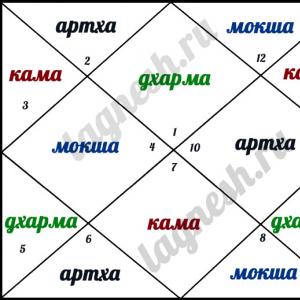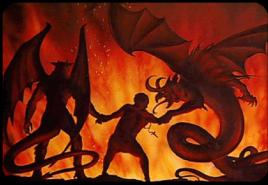Characteristic features of acmeism. Literature
Acmeism - Russian literary movement of the early XX century. Acmeism replaced symbolism, based on clarity of thought and precision of expression.
Theorists and the brightest representatives of the direction: S. Gorodetsky, N. Gumilev, A. Akhmatova, O. Mandelstam.
The Silver Age of Russian literature gave rise to several major poetic movements, the oldest of which was symbolism. By 1910 its crisis matured, the poetry of symbolism was losing its relevance, connection with reality, becoming academic.
Poets Sergey Gorodetsky and Nikolay Gumilev, in the past symbolists, in 1911 united in "Workshop of poets" to create a new school of poetry and gather young followers around him.
The term "acmeism" (flowering, peak) according to one of the versions is proposed in 1912 by Vyacheslav Ivanov, on the other - invented by Nikolai Gumilev... The movement had a second name - "Adamism", which has not received wide distribution.
The program of a new direction in versification was announced in the artistic cafe of St. Petersburg "Stray Dog".
Already in January 1913 In the magazine "Apollo" The Acmeist manifesto was published and drew a barrage of criticism and questions.
Among the complaints about the programmatic articles of the founding fathers "The legacy of symbolism and acmeism"(Gumilyov) and "Some trends in modern Russian poetry"(Gorodetsky): the discrepancy between theory and practice, the discrepancy between the creative methods of the Acmeists themselves.

Principles of Acmeism
- unclouded outlook on life, human, visible world
- certainty of images, words, objectivity of topics
- structure, organization, clarity of poetic forms
- overcoming symbolism, abstraction, aesthetics, decadence
- lyrics of everyday life life-affirming pathos
The poems of the acmeists were distinguished by their harmonious composition, accuracy of rhymes, logic, were understandable even to an inexperienced reader. Their themes were humanistic, in the center of them stood man and his creative transformation of the world.
They knew how to write about everyday things, simple joys, glorify the health of soul and body, nature, inspire to work and deeds, heroize the past of mankind. Acmeism is more gravitated towards architecture, sculpture than to music, to the balance of the knowable and the unknowable.
Among the most famous books of the adherents of the new movement are collections "Alien Sky" and "Quiver" Gumilyov, "Willow" and "Blooming Staff" Gorodetsky, "Evening" and "Rosary" Akhmatova, "Stone" Mandelstam (the book was published three times, supplemented by new verses), "Fourteen Poems" Mikhail Zenkevich.

The collapse of the "Guild of Poets"
Since 1913 acmeists, among whom were also Anna Akhmatova with Osip Mandelstam, published their own annual literary collection "Hyperborea"... He agreed to become its editor poet Mikhail Lozinsky.
The flourishing of a new school prevented the outbreak of the First World War. Gumilyov went to the front, where he stayed until January 1917... Gorodetsky also fought.
Literary life came to a standstill, the "Workshop of Poets" itself was finally disbanded in December 1914. By that time, Mandelstam had already left his ranks after the conflict with Gorodetsky.
However, the "Workshop of Poets" was briefly revived in 1916 through the efforts Georgy Ivanov, but in its composition there were no masters of acmeism, although Mandelstam sometimes attended its meetings.
"Hyperborey" became a publishing house, but existed only until 1918 year... However, in 1921 entitled "New Hyperborean" acmeists Nikolay Gumilev, Irina Odoevtseva, Nikolay Otsup, V. Rozhdestvensky published their new poems.
In a sense, this publication can be called the last attempt to revive the "Workshop of Poets" and to rally like-minded people around Acmeism. It was these people who were to publish Gumilyov's posthumous collection.
Soon myself Gumilyov was shot, some of the Acmeists became emigrants, later died in exile Mandelstam.
Acmeism as a literary movement had a short century, its theoretical basis did not have time to get the proper development, some researchers generally consider it a convention, and the poets who joined the movement were too different and original, outside the framework of any direction of modern literature.
However, acmeism managed to become a phenomenon of Russian culture at the beginning of the 20th century, associated with the names of the best poets Silver Age, became a school of excellence for poets as abroad ( Georgy Ivanov, Georgy Adamovich), and the Soviet period ( Nikolay Tikhonov, Eduard Bagritsky, Mikhail Svetlov).
Acmeism - a short-term literary movement in Russia at the beginning of the 20th century... Characterized by a departure from symbolism, uncertainty of form and content in poetry, a return to the verses of the joy of life, striving to be in harmony with nature, the world and yourself.
Famous acmeists were N. Gumilev, A. Akhmatova, O. Mandelstam.
The beginning of the 1900s was the heyday of symbolism, but by the 1910s, a crisis began in this literary movement. The attempt of the Symbolists to proclaim the literary movement and master the artistic consciousness of the era failed. The question of the relationship of art to reality, the meaning and place of art in the development of Russian national history and culture, has been sharply raised again.
A new direction had to appear, which would raise the question of the relationship between poetry and reality in a different way. This is exactly what acmeism has become.
In 1911, among poets who were striving to create a new direction in literature, a circle "Workshop of Poets" appeared, headed by Nikolai Gumilyov and Sergei Gorodetsky. The members of the "Workshop" were mostly novice poets: A. Akhmatova, N. Burliuk, Vas. Gippius, M. Zenkevich, Georgy Ivanov, E. Kuzmina-Karavaeva, M. Lozinsky, O. Mandelstam, Vl. Narbut, P. Radimov. At different times E. Kuzmina-Karavaeva, N. Nedobrovo, V. Komarovsky, V. Rozhdestvensky, S. Neldikhen were close to the "Workshop of Poets" and Acmeism. The brightest of the "younger" acmeists were Georgy Ivanov and Georgy Adamovich. A total of four almanacs "The Workshop of Poets" were published (1921 - 1923, the first under the title "Dragon", the last one was published in Berlin by the emigrated part of the "Workshop of Poets").
The creation of a literary movement called Acmeism was officially announced on February 11, 1912 at a meeting of the Academy of Verse, and in No. 1 of the Apollo magazine for 1913, Gumilyov's articles “The Heritage of Symbolism and Acmeism” and Gorodetsky's “Some Trends in modern Russian poetry ”, which were considered the manifestos of the new school.
In his famous article "The Heritage of Symbolism and Acmeism" N. Gumilyov wrote: "Symbolism is being replaced by a new direction, whatever it is called, in any case, requiring a greater balance of forces and a more accurate knowledge of the relationship between subject and object than it was in symbolism ". The chosen name of this trend confirmed the desire of the acmeists themselves to comprehend the heights of literary skill. Symbolism was very closely associated with acmeism, which its ideologists constantly emphasized, starting from symbolism in their ideas.
In the article "The Legacy of Symbolism and Acmeism" Gumilev, admitting that "Symbolism was a worthy father", said that he "completed his development circle and is now falling." After analyzing both Russian and French and German symbolism, he concluded: “We do not agree to sacrifice to him (the symbol) other methods of influence and are looking for their complete consistency”, “It is more difficult to be an Acmeist than a Symbolist, how difficult it is tower. And one of the principles of the new direction is to always follow the line of greatest resistance. "
Arguing about the relationship between the world and human consciousness, Gumilev demanded "to always remember the unknowable", but at the same time "not to offend your thoughts about it with more or less probable guesses." Negatively referring to the aspiration of symbolism to learn the secret meaning of being (it remained secret for Acmeism as well), Gumilev declared the "unchaste" knowledge of the "unknowable", "childishly wise, painfully sweet feeling of one's own ignorance", the intrinsic value of the "wise and clear" reality surrounding the poet. Thus, the Acmeists in the field of theory remained on the basis of philosophical idealism.
The acmeists' main focus was on poetry. Of course, they also had prose, but it was poetry that laid down this direction. As a rule, these were works of small volume, sometimes in the genre of sonnet, elegy. The most important criterion was attention to the word, to the beauty of the sounding verse. It is rather difficult to talk about the general theme and stylistic features, since every outstanding poet, whose, as a rule, early poems can be attributed to acmeism, had their own characteristic features.
But everywhere rhyme, rhythm and poetic meter are observed. Sentences are usually simple, without complex multi-stage turns. The vocabulary is mostly neutral, in acmeism, outdated words were practically not used, high vocabulary. However, colloquial vocabulary is also absent. There are no examples of "word creation", neologisms, original phraseological units. The verse is clear and understandable, but at the same time it is unusually beautiful. If you look at the parts of speech, then nouns and verbs prevail. There are practically no personal pronouns, since acmeism is more addressed to the outside world, and not to the inner experiences of a person. Various means of expression are present, but they do not play a decisive role. Of all the tropes, comparison prevails. Thus, the Acmeists did not create their poems at the expense of multistage structures and complex images - their images are clear, and the sentences are quite simple. But they are distinguished by the desire for beauty, the sublimity of this very simplicity. And it was the acmeists who were able to make ordinary words play in a completely new way.
Despite numerous manifestos, Acmeism still remained poorly expressed as a holistic trend. His main merit is that he was able to unite many talented poets. Over time, all of them, starting with the founder of the school Nikolai Gumilyov, "outgrew" acmeism, created their own special, unique style. However, this literary direction somehow helped their talent develop. And for this alone, it is possible to give Acmeism an honorable place in the history of Russian literature at the beginning of the 20th century.
But nevertheless, one can single out the main features of the poetry of Acmeism. First, attention to the beauty of the surrounding world, to the smallest details, to distant and unknown places. At the same time, Acmeism does not seek to know the irrational. He remembers it, but prefers to leave it intact. As for the stylistic features directly, this is the desire for simple sentences, neutral vocabulary, the absence of complex phrases and a pile of metaphors. However, at the same time, the poetry of Acmeism remains unusually bright, sonorous and beautiful.
Acmeism is one of the modernist trends in Russian poetry.
It fell on the heyday of the Silver Age.
The ideological inspirers of Russian acmeism are considered to be the poets N. Gumilyov and S. Gorodetsky.
Aesthetic maturity of poetry
Throughout its existence, poetry has undergone many different trends and directions. In the first decade of the 20th century, in contrast to symbolism in Russian poetry, a new modernist trend was formed - acmeism. Translated from Greek, this term means the highest degree, peak, maturity, flowering.
Creative people, especially poets, are often far from concepts such as modesty. Almost everyone considers himself a genius, or at least a great talent. This is how a group of young poets, connected not only by creativity, but also by personal friendship, resented the harsh criticism of one of them, Nikolai Gumilyov, and created their own association with a somewhat craft name "Poets' Workshop".
But already in the name itself, there is a desire to look like not just lovers of the lyric poetic genre, but to be artisans, professionals. Acmeists published the magazines Hyperborey and Apollo. Not only poems were published there, but also controversy with poets of other directions in the prose genre was conducted.

poets acmeists photo
The ideological inspirers of acmeism, Nikolai Gumilev and Sergei Gorodetsky, published in these journals a kind of program manifesto of a new poetic movement.
Basic concepts of acmeism
- Poetry should be expressed in a clear and understandable style;
- the reality and vitality of feelings and actions are much more important than emasculated, idealized, far-fetched and sensual concepts;
- frozen symbols should not prevail over the human worldview;
- it is necessary to completely abandon the mystical credo;
- earthly life is full of diversity and color, which must be brought into poetry;
- a poetic word should sound precise and definite - every object, phenomenon or deed should be voiced clearly and understandably;
- a man with his genuine, primordial, one might even say biological emotions, and not invented, sleek and lacquered feelings and experiences - this is a worthy hero of real poetry;
- Acmeists should not reject past literary eras, but take from them aesthetically valuable principles, have an inextricable connection with world culture.
Acmeists considered the Word to be the foundation of their poetry. The backbone of the first composition of the "Guild of Poets" consisted not only of poets who were close in their ideology, but also people connected by bonds of friendship. Subsequently, the names of these poets were included in the Golden Fund of Russian Literature.
The Acmeist Poets
- Sergei Gorodetsky was born in the 90s of the 19th century. He received an excellent education in a truly intelligent family, where morality, culture and education were considered the main values. At the time of the creation of Acmeism, he was a famous poet.
- Nikolai Gumilev is an extraordinary and talented person, a romantic with a very courageous appearance and a subtle soul. From a young age, he tried to establish himself as a person and find his place in this difficult life. Very often, this desire grew from a position to a pose, which may have led to an early and tragic death.
- Anna Akhmatova is the pride, glory, pain and tragedy of Russian poetry. The poetic soul of this courageous woman gave birth to piercing words about the great mystery of love, placing her poems among the beautiful creations of immortal Russian literature.
- Osip Mandelstam is a poetically gifted young man with a keen sense of art. Poems, in his own words, overwhelmed him and sounded like music in him. He considered his friendship with Nikolai Gumilyov and Anna Akhmatova the most important success of his life.
- Mikhail Zenkevich, a poet and translator, the only one of the founders of acmeism, survived until the 80s of the 20th century, safely avoiding repression and persecution.
- Vladimir Narbut, a young poet, belonged to the circle of visitors to the Tower of Vsevolod Ivanov, warmly embraced the idea of acmeism.
Outcome
As a literary movement, Acmeism existed for just over two years. For all the controversy of the concepts of this direction, its value is not only in the fact that it was exclusively a Russian trend, but in the fact that the work of wonderful Russian poets is associated with acmeism, without whose work it is impossible to imagine Russian poetry of the 20th century.
Acmeism occupies a special place among all trends in the poetry of the Silver Age. And not only because this literary movement united the outstanding Russian poets of the turn of the century, - any of the trends of modernism in Russian literature can "boast" of famous names. The poetry of Acmeists is remarkable in that it “overcame symbolism” and returned to an accurate and clear word, achieved restraint and conciseness of style, rigor and harmony of poetic structure. In the verses of representatives of this movement, especially Anna Akhmatova, the semantic space of the text received an extraordinary expansion. Very little has been said, but what is guessed behind the pictorial details, what is hidden between the lines, is so extensive in its content, in evoked feelings and emotions, that the reader freezes in amazement and admiration.
So helplessly my chest grew cold
But my steps were easy.
I put it on my right hand
Left hand glove.
A striking example is Anna Akhmatova's poem "The Song of the Last Meeting" (1911).
It would seem that a clear and clear object image, but how many associations this brevity evokes, how much is not expressed verbally, but it is guessed, thought out. This is acmeism.
Features of acmeism
- return to the primary meaning of the word, to the clarity and accuracy of images;
- the image of the real objective world, the rejection of mysticism and nebulous symbolism;
- passion for objectivity, attention to detail;
- stylistic balance, refinement of the composition;
- an appeal to past cultural eras, the perception of world culture as a common memory of mankind;
- preaching the "earthly" attitude, poeticization of the world of primordial nature.
Acmeism as a literary movement
Acmeism arose in opposition to Symbolism and, one might say, in the depths of Symbolism, because young future acmeist poets learned from the Symbolists poetic technique. They read their poems in Vyach's "tower". Ivanov, listened to the critical remarks of senior colleagues and at first did not think that they were forming a new literary direction. But the rejection of Symbolist theories first united them into a "circle of young people", and then they separated from the Symbolists altogether and organized the "Workshop of Poets", began to publish their own magazine "Hyperborey". It was there that they published their articles about the new literary movement, their poems. At one of the meetings of the "Guild of Poets" in 1912, it was decided to announce the creation of a new poetic movement. Of the two proposed names - Acmeism and Adamism - the first stuck. It is based on the ancient Greek word meaning "top, the highest degree of anything." Acmeists considered their work to be such a pinnacle.
Acmeists were such poets as Nikolai Gumilyov, Anna Akhmatova, Osip Mandelstam, Sergei Gorodetsky, Mikhail Zenkevich, Mikhail Lozinsky, Vladimir Narbut and others.
This literary movement did not last long, since a detailed philosophical and aesthetic program was not created, and the framework of a single poetic trend turned out to be tight for such talented poets as Gumilyov, Akhmatova, Mandelstam. By the beginning of World War I, acmeism had split, and although then attempts were made to revive the union (in 1916, the second "Workshop of Poets", in 1920 - the third), acmeism never became the leading poetic trend.
Acmeism in Russian literature
Acmeism is a literary trend that is characteristic only of Russian literature. This uniqueness makes Acmeism even more interesting. At present, interest in acmeism, perhaps, is due to the fact that the fate and work of acmeist poets, who had a huge influence on the poetry of the twentieth century, are associated with it.
The merit of the acmeists is that they have found special, subtle ways of conveying the inner world of the lyrical hero. Often the hero's state of mind was conveyed by movement, gesture, listing of things that generated many associations. Such a "materialization" of experiences is characteristic of many of Anna Akhmatova's poems.
Akhmatova's poetic genius is manifested in the choice and placement of details that give rise to the semantic depth of the text. The neighborhood of details is often unexpected. The messages about the actions and feelings of the lyrical heroes are accompanied by descriptions of the nature or space of the city with its architecture, images of world literature, references to historical events, about historical heroes. In terms of the strength of the impact, Akhmatova's poems are truly the pinnacle of poetry, and in them the meaning of the name "acmeism" becomes fair.
"Workshop of poets" - the founders of acmeism
Acmeism is one of the modernist trends in Russian poetry, which was formed at the beginning of the twentieth century as the art of completely accurate and balanced words, opposed to symbolism. The Acmeism program was officially announced on December 19, 1912 in St. Petersburg.
Acmeism overcame symbolist aspirations imbued with extreme mysticism and individualism. Symbolism, innuendo, mystery and vagueness of images that evoked correspondences and analogies, symbolism were replaced by clear and clear, unambiguous and refined poetic verbal images.
Guided by a real view of things, Acmeism proclaimed the materiality, specificity, accuracy and clarity of the text, it significantly stood out among literary movements in a number of its features: a separate approach to each object and phenomenon, their artistic transformation, the use of art in the ennobling of human nature, the clarity of the poetic text ( "Lyrics of impeccable words"), aestheticism, expressiveness, uniqueness, definiteness of images, portrayal of the material world, earthly beauties, poeticization of the feelings of primitive man, etc.
The origin of the term "acmeism"
The term "acmeism" was introduced by NS Gumilev and SM Gorodetsky in 1912 as a new literary trend as opposed to symbolism.
The name of the direction behind the words of Andrei Bely appeared during the discussion between V.V. Ivanov and N.S. poets. Hence the other used name for acmeism - "adamism".
Due to the spontaneous choice of the name of the group, the concept of acmeism was not entirely justified, which caused the doubts of critics about the legitimacy of the term. Acmeism could not be precisely defined as participants in the movement, among whom the poet O.E. Mandelstam, linguist and literary critic V.M. Zhirmunsky, as well as researchers of Russian literature: R.D.Timenchik, Omri Ronen, N.A.Bogomolov, John Malmstad and others. Therefore, the number of adherents of acmeism varies depending on what is invested in the content of this concept. The movement usually includes six poets.
Their contemporaries found another meaning of the term. For example, VA Piast found its beginnings in the pseudonym of Anna Akhmatova, which in Latin sounds “akmatus”, similar to the meaning of the Greek “akme” - “edge, tip, edge”.
The formation of acmeism took place under the influence of the creativity of the "Guild of Poets", the opposition group of the "Academy of Verse", the main representatives of which were the creators of acmeism Nikolai Gumilyov, Sergei Gorodetsky and Anna Akhmatova.
The concept of "acmeism" is not well-grounded in the manifestos of the commonwealth. Even the main members of the group did not always adhere to the basic tenets of the Acmeist manifestos in practice. But, for all the vagueness of the term, the absence of its specificity, "acmeism" embraces the general ideas of the poets who proclaim materiality, the objectivity of images, and the clarity of words.
Acmeism in literature

Acmeism is a literary school consisting of six gifted and different poets, who were primarily united not by a common theoretical program, but by personal friendship, which contributed to their organizational cohesion. In addition to its creators, N. S. Gumilyov and S. M. Gorodetsky, the commonwealth included: O. E. Mandelstam, A. Akhmatova, V. I. Narbut and M. A. Zenkevich. VG Ivanov also tried to join the group, which was disputed by Anna Akhmatova, according to which "there were six acmeists, and there never was a seventh." Acmeism is reflected in the theoretical works and works of fiction of writers: the first two manifestos of acmeists - articles by N. S. Gumilyov "The Heritage of Symbolism and Acmeism" and S. M. Gorodetsky "Some Trends in Contemporary Russian Poetry", were published in the first issue of the magazine "Apollo" in 1913, from which it is customary to consider acmeism as a literary trend, the third manifesto - the article by O. E. Mandelstam "The Morning of Acmeism" (1919), written in 1913, was published only 6 years ago due to the divergence views of the poet with the views of N. S. Gumilyov and S. M. Gorodetsky.
The poems of the Acmeists were published after the first manifestos in the third issue of Apollo in 1913. In addition, during 1913-1918. published a literary magazine of poets-acmeists "Hyperborean" (hence another name for acmeists - "Hyperboreans").
The predecessors of acmeism, whose work served as its basis, N. S. Gumilev calls in his manifestos: William Shakespeare, François Villon, François Rabelais and Théophile Gaultier. Among Russian names, such cornerstones were I. F. Annensky, V. Ya. Bryusov, M. A. Kuzmin.
The principles indicated in the manifestos sharply contradicted the poetry of the members of the association, which attracted the attention of skeptics. Russian symbolist poets A. A. Blok, V. Ya. Bryusov, V. I. Ivanov considered Acmeists as their followers, futurists perceived them as opponents, and supporters of Marxist ideology who replaced them, starting with L. D. Trotsky, called Acmeists an anti-Soviet trend desperate bourgeois literature. The composition of the school of acmeism was extremely mixed, and the views of a group of acmeists represented by V. I. Narbut, M. A. Zenkevich, and partially S. M. Gorodetsky himself significantly differed from the poetic aestheticism of the poets of pure “acmeism”. This discrepancy between poetic views within one movement prompted literary scholars to think long and hard. It is no wonder that neither V. I. Narbut and M. A. Zenkevich were members of the second and third professional associations "Workshop of Poets".
Poets tried to leave the current before, when in 1913 V.I. Narbut suggested to M.A.Zenkevich to leave the commonwealth of acmeists and create a separate creative group of two people or join cubo-futurists, whose harsh concepts were much closer to him than refined aesthetics Mandelstam. A number of literary researchers came to the conclusion that the creator of the association, S. M. Gumilyov, deliberately tried to combine inorganic creative ideologies in one movement for the euphonious polyphony of a new unlimited direction. But it is more likely that both sides of Acmeism - the poetical-Acmeist (N. S. Gumilyov, A. Akhmatova, O. E. Mandelstam) and the materialistic-Adamist (V. I. Narbut, M. A. Zenkevich, S. M. Gorodetsky) - united the principle of deviation from symbolism. Acmeism as a literary school comprehensively defended its concepts: opposing himself to symbolism, he simultaneously fought the frantic word-creation of the parallel trend of futurism.
Decline of Acmeism

In February 1914, when there was a discord between N. S. Gumilev and S. M. Gorodetsky, the first school of mastering poetic skills, the "Workshop of Poets", fell apart, and Acmeism fell. As a result of these events, the direction was subjected to harsh criticism, and BA Sadovskoy even declared "the end of acmeism." Nevertheless, the poets of this group were called Acmeists in publications for a long time, and they themselves did not cease to refer themselves to this direction. Inherited and secretly continued the traditions of acmeism were four students and comrades of N. S. Gumilyov, who are often referred to as junior acmeists: G. V. Ivanov, G. V. Adamovich, N. A. Otsup, I. V. Odoevtseva. In the works of his contemporaries, there are often young writers, like-minded people of Gumilyov, who are inherent in the ideology of the "Guild of Poets".
Acmeism as a literary movement existed for about two years, having published 10 issues of the Hyperborey magazine and several books, leaving a priceless legacy of the eternal words of outstanding poets who had a significant impact on Russian poetry of the 20th century.
The word acmeism comes from the Greek word acme, which means: peak, peak, highest point, flowering, strength, edge.







